by Editor | Jul 13, 2015 | Food
By Elena del Valle and photos by Gary Cox
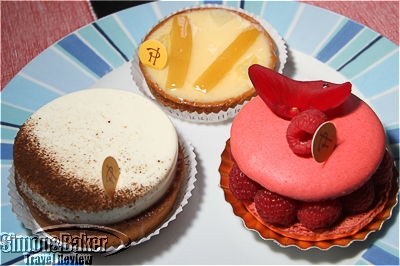
Delicious Pierre Hermes desserts

Caramel salted butter, white truffle, tangerine and rose macarons
For many years we have sampled baked goods and chocolates in various neighborhoods in the City of Lights with mixed results. Our tastings and discoveries have led us to a few favorites we return to whenever we are in Paris, France. For example, we like the Pierre Hermes shop on rue Bonaparte in the Latin Quarter. We have been there many times over the years (see Paris macaron maker remains a favorite). It has been our experience that while the shop is small and often crowded the staff members are friendly and efficient. We find the pain au chocolat, Ispahan croissants, Infiniment Vanille tart and single flavor macarons worth hoofing it there from nearby neighborhoods. Our preferred macaron flavors have been caramel salted butter, white truffle, rose and tangerine. Recently, we also sampled the Ispahan Gaufre, a soft cookie sandwich with a waffle like appearance and rose and raspberry filling sold in a single sealed sleeves. In addition to the taste we liked the Gauffre’s slightly longer shelf life compared to the fresh baked goods which only lasted a few days.
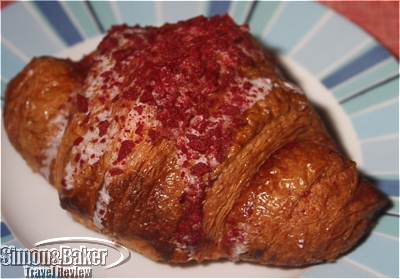
The Isbahan croissant became a new favorite.
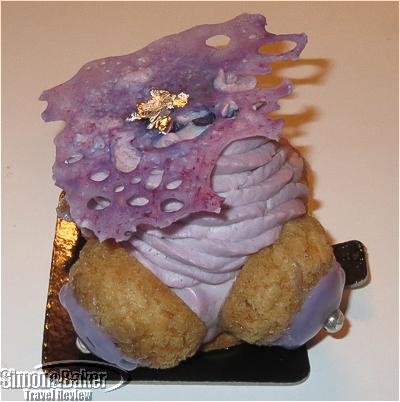
The Lilly Valley from Carl Marletti
In the Left Bank, we liked the vanilla eclairs at La Parisienne bakery on rue Monge. When we were in the mood for our favorite vanilla eclairs we went to Carl Marletti on rue Censier. It was also home of the Lilly Valley, another favorite pastry worth a special trip. It was best to arrive early in the day to avoid leaving empty handed as they sometimes sold out of the Lilly Valley. In the Right Bank, the vanilla eclairs at Stohrer on rue Montorgueil, said to the be oldest bakery in the city, and the mini pain au chocolat were worth a stop.
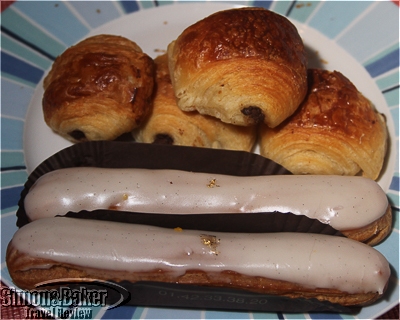
Vanilla eclairs and mini pain au chocolat from Stohrer
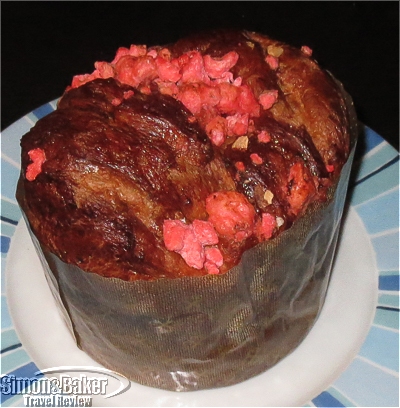
Praline bread from Eric Kayser
We walked to the Eric Kayser bakery on rue Monge for its good cereal baguette and moist mini financier pastries. For small brioches with praline that remind us somewhat in texture and flavor of Hawaiian bread we made our way to the shop on rue des Petits Careaux at the top of rue Montergueil.
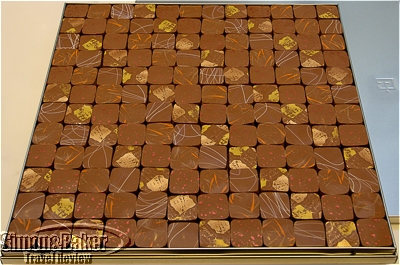
Jacques Genin chocolates
For exceptional candy including artisan marshmallows, marron glaces and candied chestnuts (smaller than the marron glaces) in season, and pate de fruit from the Basque Region we popped into Bon Bon au Palais on rue Monge. If craving delicate chocolate bites we headed to Jacques Genin on rue de Turenne on the Right Bank (see Passionate chocolate, candy maker draw to Paris Marais shop) or the new Left Bank location on rue de Varenne (see Paris chocolate, candy maker opened new Left Bank shop).

Mendiant chocolate bar from Manufacture
For hearty extraordinary single source chocolate bars we loved the new Alain Ducasse Manufacture shop on rue Saint Benoit in the Left Bank (see Alain Ducasse new Left Bank shop worth a visit for single source dark chocolate). While smaller than the original shop and manufacturing facility on rue de la Roquette on the Right Bank (see The art of making chocolate Alain Ducasse style in Paris) it had the same products on offer. The staff members we met were well informed, service oriented and helpful. In a pinch we would consider the Manufacture stand at the Gallery LaFayette Gourmet store, but only if we happened to be in that area.
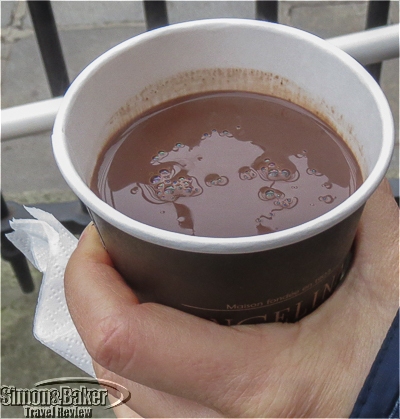
Thick chocolate to go from Angelina
Our favorite way to enjoy hot chocolate was to buy a cup of take out from the Angelina Cafe on rue de Vaugirard on the Left Bank next to the Luxemburg Museum. Served pipping hot it had a dark rich tart flavor that drew us back over and again. The only down side was the take out came without the whipped cream. The rue de Rivoli main shop (and salon) on the Right Bank also sold the hot chocolate to go, but the one time we tried it the hot chocolate was sweeter, milkier and missing the tart finish we liked so much.
by Editor | Apr 27, 2015 | Food
By Elena del Valle and photos by Gary Cox
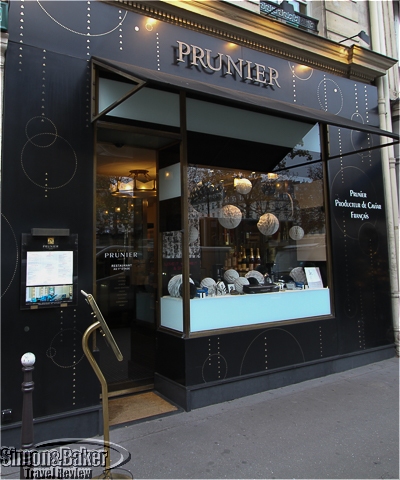
The Prunier shop on Place de la Madeleine, Paris

Inside the Prunier shop – click to enlarge
Tasting more than one type of caviar at a time is not ideal, the sales lady at Prunier, a specialty shop on the ritzy Place de la Madeleine in Paris, France, said when I asked about sampling several varieties of the delicate seafood. She went on to explain that most people’s palate has trouble distinguishing the flavors in the same way that after sampling several wines it becomes difficult to taste the nuances of each consecutive one.
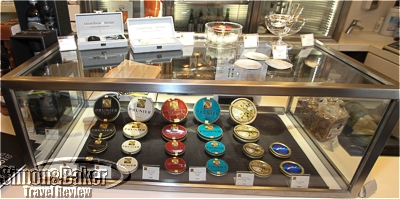
The Prunier shop had a selection of caviar cans on display.
So it was that we settled on only one kind of the four caviar types sold at the shop instead of the two or more varieties we had anticipated when we planned a caviar tasting. We also sampled some Norwegian farm raised Balik salmon which she said tasted “like candy.”
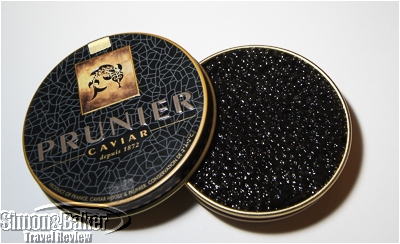
The Prunier Tradition Caviar we sampled. (click to enlarge)
She recommended the Tradition Caviar, explaining that it accounted for as much as 60 percent of the company’s caviar production. Ours was from the most recent production of September 2014 and had been aged one month. We took home a 30 gram tin of Tradition, a farmed caviar from Montpon Menesterol in France, for each of us. We also took a 120 gram vacuum pack of Balik Norwegian farmed salmon smoked in Ebersol, Switzerland. They came in insulated sealed plastic bags with small frozen packs.
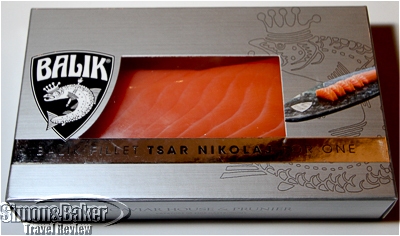
A box of Balik salmon for one.
The products would be at their best if we refrigerated them within five hours so we made our way back to our place with alacrity, arriving within an hour and placing the bags in the refrigerator immediately. They sat in the corner while we fretted with anticipation until the following afternoon when we sampled them with a glass of well chilled brut champagne.
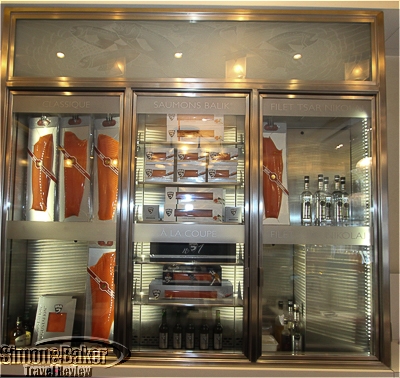
The salmon display case with a variety of cuts and sizes.
Following her advice we had the caviar by itself first. It was buttery with a pleasing texture, a mild flavor and just the right amount of salt to highlight its natural taste without being too salty. There was also a hint of nuttiness and a pleasant aftertaste but no fishiness.
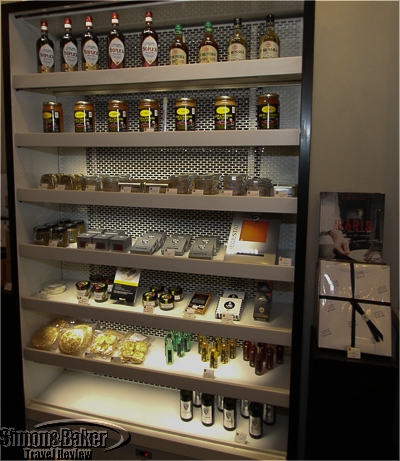
There was a case containing other products like foie gras and blinis.
The salmon too was subtle and had a buttery melt-in-your-mouth texture. We sliced it into bite size chunks and ate it by itself with no garnishes or condiments. Each package was a single serving which was plenty, yet it seemed to disappear as if by magic. I would buy both products again and recommend them to friends, especially if it is their first time tasting caviar and salmon. Boutique Prunier (15 place de la Madeleine, 75008 Paris, France, +33 147429898, www.prunier.com, info@prunier.com), a 50 square meter ground level shop, was established in 2005.
by Editor | Apr 13, 2015 | Food
By Elena del Valle and photos by Gary Cox
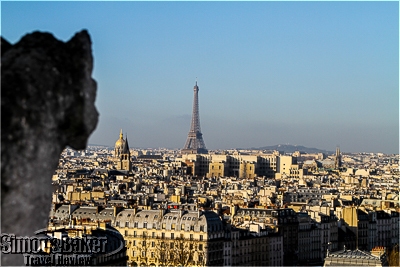
A unique view of Paris from atop Notre Dame. (click to enlarge)
Paris, France is an exceptional city when it comes to restaurants and food. In addition to a variety of neighborhood size supermarket stores, specialized food shops small and large, single and chain owned, domestic and foreign can be found across the city. As if that wasn’t enough street market vendors sell fresh seafood, ethnic foods, produce, flowers, dairy products and merchandise several times a week in various city neighborhoods.
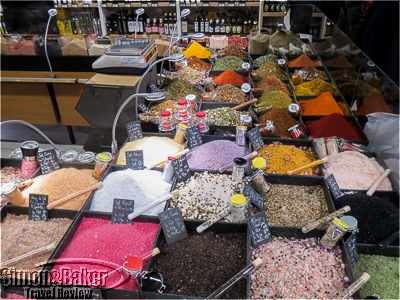
A variety of salts at the Galeries Lafayette Maison
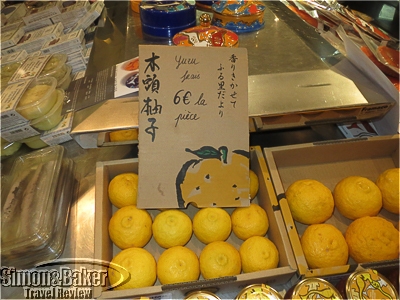
Yuzu citrus from Japan
Prices are high and the shelf life of fresh products short so it pays to shop often and with care, and to pay attention when making purchases lest the produce wilt or spoil in the refrigerator before we consume it. Over the years we have discovered that the best way to shop for us is to pick and choose favorite products from a variety of vendors in our area. For example, we usually find a neighborhood bakery and grocer for regular purchases. In addition, for special occasions and when we just want to treat ourselves to something out of the ordinary there are a number of sellers we find are worth a special trip or detour.
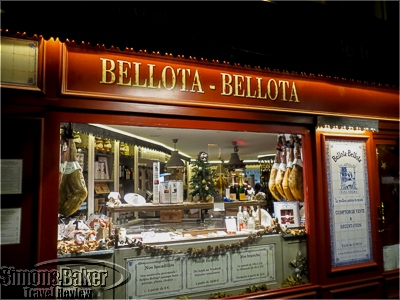
The Bellota Bellota shop and eatery in the Latin Quarter
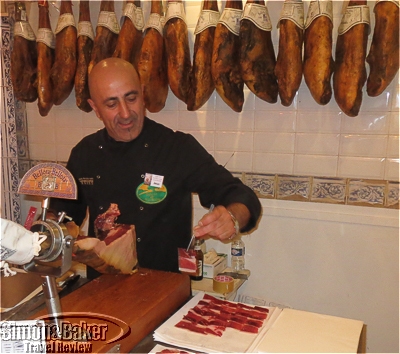
Slicing bellota ham requires skill (click to enlarge)
For over the top wonderful bellota ham from Spain and related products we like the Bellota Bellota store on rue de Seine in the Latin Quarter (see Paris Latin Quarter gourmet shop new favorite). They offered eat in (though we found it too chilly to eat there on cold days) and take out options as well as freshly sliced and vacuum packed options. Most recently we tried Le Royal sandwich made with slices of master cortador cut bellota, manchego cheese and homemade smashed tomatoes. The single slice of cheese and single slice of bellota tasted best after removing one of the halves of the thick and crunchy bread.
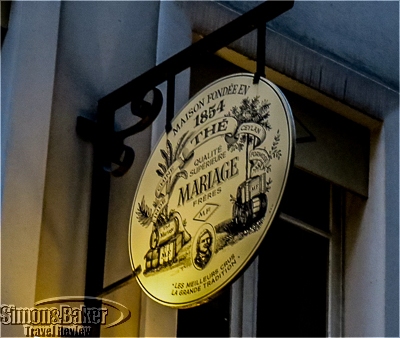
The distinctive Marriage Freres sign marked the location of fine teas

A turkey club at the Carrousel du Louvre location of Mariage Freres
When we are in the mood for tea and a light meal at a teashop we make our way to Mariage Freres on rue Bourg-Tibourg in the Right Bank for their Snob Salad and Louvre sandwich (see Superb gourmet lunch at Paris tea salon). Although on our most recent visit the service was slower and less attentive in the tea salon and shop by far than in past occasions the food was good. We generally stay away from the too touristy Carrousel du Louvre location, especially in cold weather. We have found the underground shopping center next to the Louvre Museum to be overcrowded, and the only bathroom for teashop customers was an equally crowded pay for use mall facility outside the eatery. Although clean and maintained by onsite staff it required exiting the tea shop and walking over public bathroom, payment of 1.50 euros and standing in line.
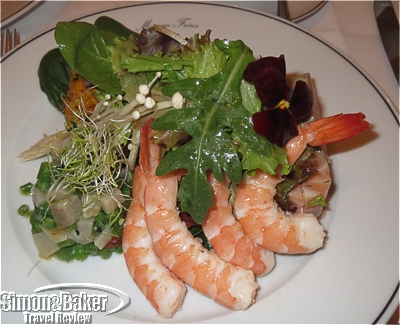
The Snob Salad at the Grand Augustin shop (click to enlarge)
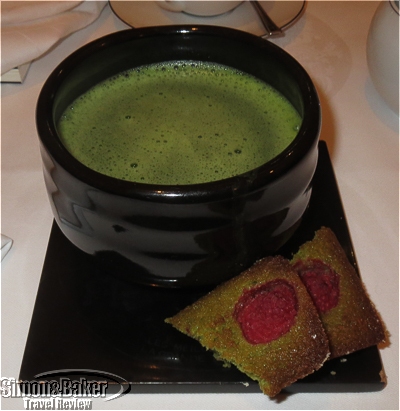
A cup of matcha tea whipped and served in a special cup
On our most recent stay in the City of Lights, we visited the shop and tea salon at Grands Augustins on the Left Bank. While we were disappointed the shop did not carry the match tea flavor we liked from the tea salon or offer any date for its availability (the staff person responded stiffly when we asked) the tea salon experience was pleasant and the service attentive. The Snob Salad was slightly different and less to our liking than the one on rue Bourg-Tibourg.

Table D’Aki changed its name to La Table d’Akihiro
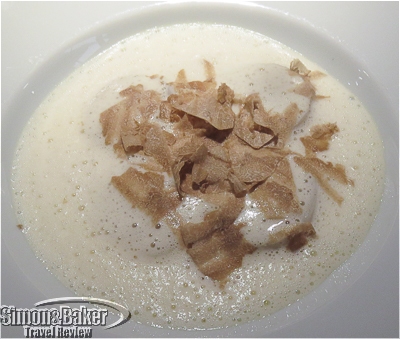
The scallops with white truffles were outstanding
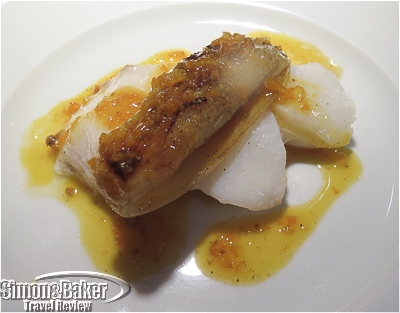
A delicate fish served with caramelized endive (click to enlarge)
For dependable, fresh, beautifully prepared and presented seafood we beeline our way to Table d’Akihiro in the Left Bank (see Same outstanding seafood Paris restaurant, updated name). While advance reservations have been a must, and menu selection in the past was limited to one or two appetizers, one or two mains and one dessert, the meals have always been exceptional and outstanding value for money.
by Editor | Mar 30, 2015 | Food
By Elena del Valle
Photos by Gary Cox
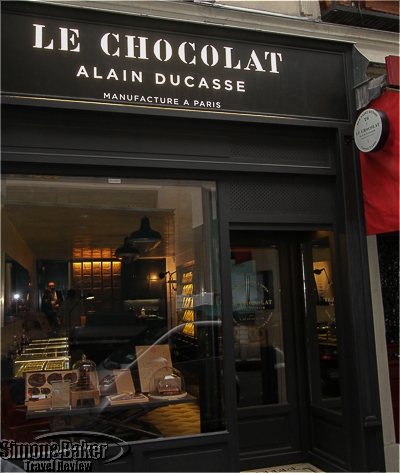
Le Chocolat storefront on Rue Saint-benoite
Paris, France is a city where many bakeries sell chocolates and specialized chocolate shops abound. Some shops sell handmade chocolates made onsite while others tout imported bonbons. Some vendors, especially in tourist areas, attract buyers with elaborate chocolate art and sculptures, sparsely stocked display cases, uniformed and gloved staff, and the high prices that might mean high quality, but don’t necessarily deliver on the implied promises.
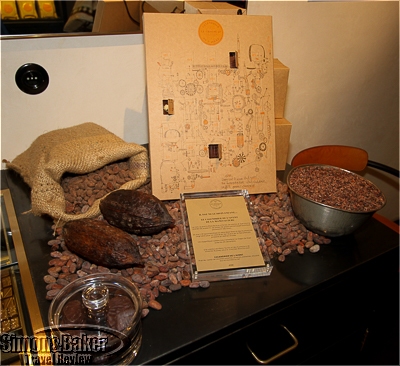
Inside the store there was information and a display of the raw ingredients for chocolate (click to enlarge)
With such a plethora of choices what makes one chocolate seller rise above the rest despite simple, some might say understated, wrapping and boxes? Chocolates, especially single source dark chocolate bars, made from scratch in the shop’s own factory with organic ingredients. At this newly opened shop there were no artificial or from frozen ingredients, flavor enhancers, additives or preservatives in the products. In December 2013 we featured the factory (see The art of making chocolate Alain Ducasse style in Paris).
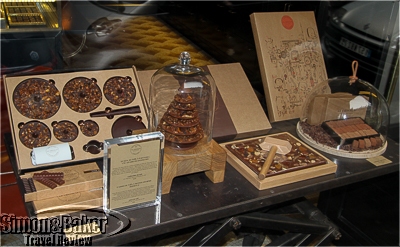
Specialty chocolate gift items in the window display
On our most recent visit to the City of Lights we discovered Le Chocolat Alain Ducasse’s new Left Bank location on a side street off the famed Boulevard Saint Germain (26, rue Saint-benoit, 75006, Paris, +33 01 45 48 87 89, http://www.lechocolat-alainducasse.com, contact@lechocolat-alainducasse.com). We returned often during our stay.
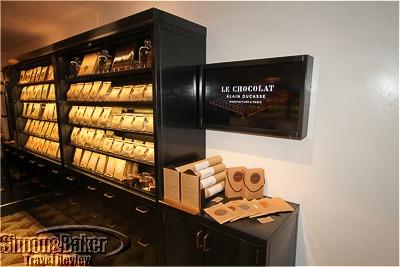
A video about the making of the chocolate ran on a screen (click to enlarge)

A chocolate spread and hot chocolate mix display (click to enlarge)
Opened in March 2014 the 30 square meter shop was owned by Alain Ducasse, he of the culinary empire. Despite the unobtrusive facade (we almost missed it on our first visit due to nearby construction) the shop was busy every time we were there. We were so distracted browsing the chocolate filled shelves and display cases on either side we almost missed the wall mounted television screen with presentations on the factory and manufacturing process, and the pretty original tiled floor.
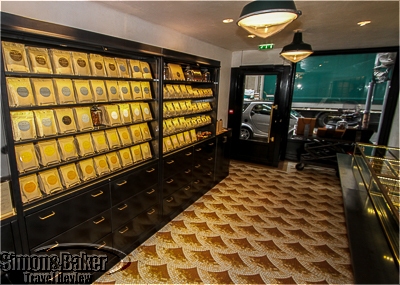
Note the chocolate bars on display and the historic tile floor (click to enlarge).

A glass covered display case housed a variety of chocolate covered bonbons (click to enlarge).
On sale in a tall wall case, in brown paper foil lined resealable bags, were 48 varieties of chocolate bars. The design on the bars, available in 100 percent (only one), 75 percent, 65 percent, and 45 percent, was by Pierre Tachon. On the opposite side of the shop, there were also 25 types of bonbons, dragées, roc’s, soveria candied fruits, chocolate chips and chocolate spread (in glass jars) all made at the city factory in the eleventh arrondisement.
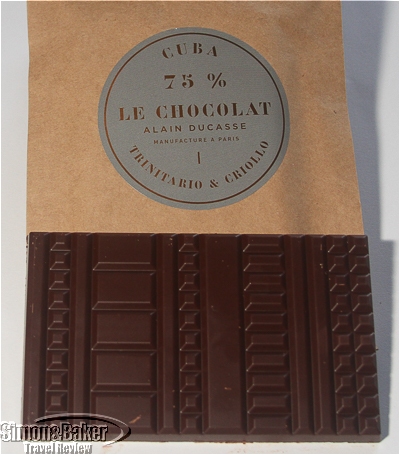
Chocolate made from Cuban Trinitario and Criollo beans
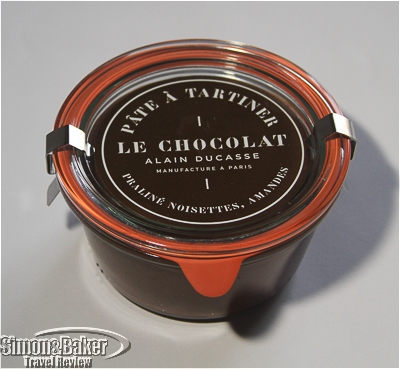
Chocolate and hazelnut spread
Under the careful supervision of the factory staff, the products were manufactured from cacao imported from small farms in 13 countries: Ecuador, Venezuela, Peru, Madagascar, Mexico, Granada, Sao Tome, Java, Dominican Republic, Trinidad, Vietnam, Cuba, and Brazil. To sweeten the brown paste the makers used organic non refined sugar. Italian artisan candied fruits were added to some bars including the muesli chocolate. The milk chocolate muesli chocolate bars, Mendiant Lacte Muesli 45 percent, quickly became my favorite item. Like the truffles and pralines they had a relatively short shelf life compared to the dark chocolate bars, but that was never a problem as they didn’t last long. I can’t wait to return to Paris to buy a stack.
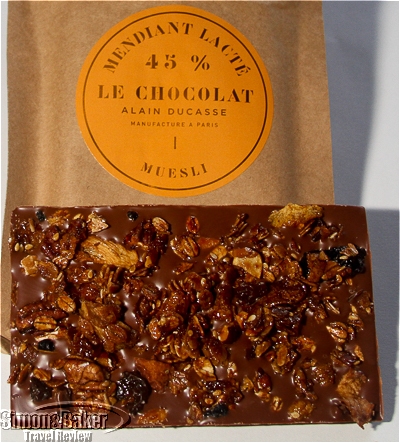
A favorite: milk chocolate with muesli
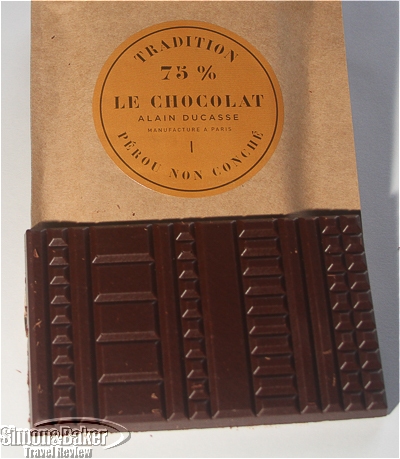
Peruvian chocolate that had not been conched
We sampled the chocolate spread, and a box each of truffles and praline chocolates. From the chocolate bars we had mostly plain dark chocolate varieties although the Fourree made with coconut and passion fruit filling was another favorite. The single source bars we tried were 75 percent dark chocolate Venezuela Porcelana Criollo (a favorite with a sweet and tart finish), Sao Tome Forastero Amelonado, Cuba Trinitario Criollo (satisfyingly dark without being too sharp), Tradition Perou Non Conche (a favorite from our previous tasting, it was slightly gritty yet rewarding), and Bresil Trinitario. The Brazilian had a dark flavor with hints of tobacco while the Sao Tome was tart with a touch of spice. The Brazilian and Cuban flavors were new and was the 100 percent Peruvian chocolate bar. We tried 100 percent Perou Trinitario, made exclusively from Peruvian cacao. It was sharp and bitter, an acquired taste.
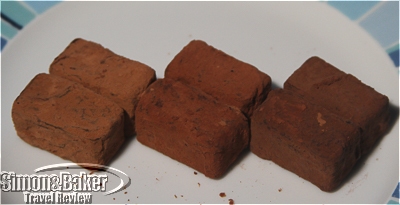
Various chocolate truffles coated with cocoa powder
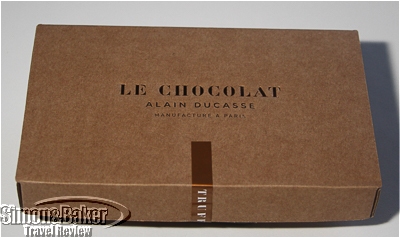
The truffles came in a cardboard box
Kudos to Alain Ducasse and Nicolas Berger, the passionate man behind the chocolate factory, for their artisanal chocolate products, in particular the single source dark chocolate bars (and muesli milk chocolate bars for milk chocolate fans) worthy of a detour.
by Editor | Jan 5, 2015 | Food
By Elena del Valle
Photos by Gary Cox
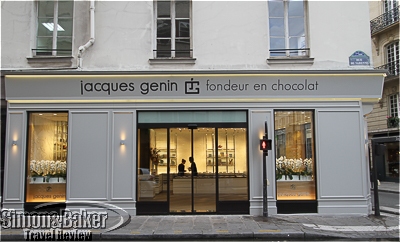
The exterior of the Left Bank shop
About two years ago we visited the Jacques Genin, fondeur en chocolat factory and shop in the Right Bank of Paris, France (Passionate chocolate, candy maker draw to Paris Marais shop) where we met the enthusiastic chocolate and candy maker and tasted some of his creations. Recently, we visited his new 80 square meter Left Bank corner shop (27 rue de Varenne, 75007 Paris, France,+33 1 53 71 72 21, www.jacquesgenin.fr) and carried home goodies to taste. We liked that they were made fresh at the Jacques Genin factory in Paris from all natural ingredients.
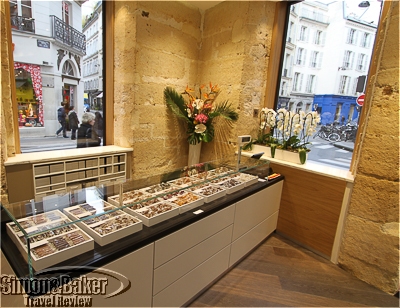
Flowers and large windows made the shop bright and cheerful – click to enlarge
The brightly lit spacious shop was a treasure trove of candy, displayed behind elegant glass topped cases. It occupied a prominent corner in the well heeled seventh arrondissement.
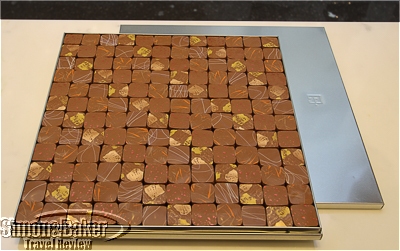
A box of milk chocolates – click to enlarge
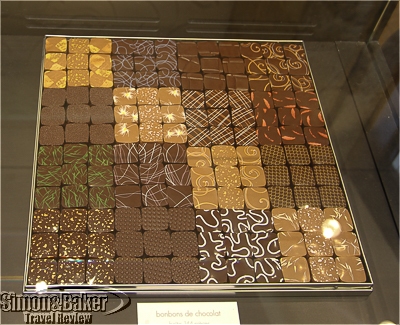
Distinctive markings formed designs that identified the various flavors – click to enlarge.
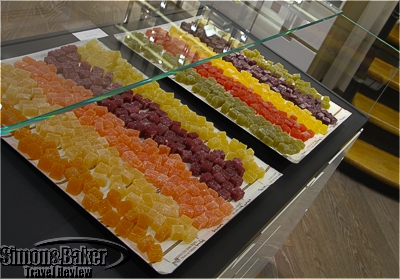
Fruit and vegetable candies added a touch of color – click to enlarge.
Once again we were delighted with the fragrant and delicate flavors in his bite size chocolates which had to be consumed within a week. A distinctive pattern or design on each chocolate was useful in identifying the filling by referring to a card the staff provided with our two boxes of nine chocolates each. Three types of chocolate were described in French on the card as well as candy like the caramels and pates de fruit flavors. There were three main categories of chocolate: dark, milk and praline. The praline was available in dark and milk chocolate flavors. Among the flavors we sampled was dark chocolate chestnut honey, dark chocolate mint and almond, dark chocolate praline, dark chocolate almond praline and milk chocolate hazelnut praline. We were unable to identify all of the flavors.
The chocolate and pate de fruit came in the distinctive square metallic boxes we recognized from our previous visits to the chocolate shops. We tasted some of the products from his new line of pates de fruits vegetable candy made from seasonal produce such as turnip, beetroot, carrot, celery, fennel, sweet pepper, and cucumber. While we appreciate their special nature they were not favorites. The next time we visit one of his shops, we’ll revert back to the fruit candy we have enjoyed in the past.
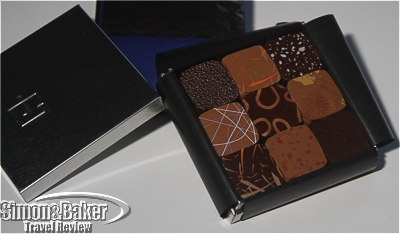
The box of chocolates and praline we tried – click to enlarge
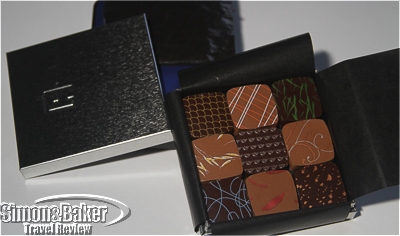
The box of chocolates we tried – click to enlarge
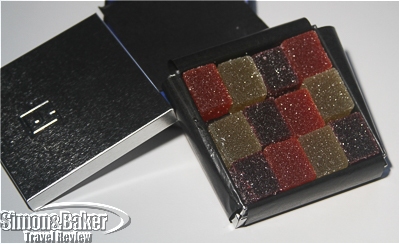
The box of the new vegetable Pate de fruit we tried
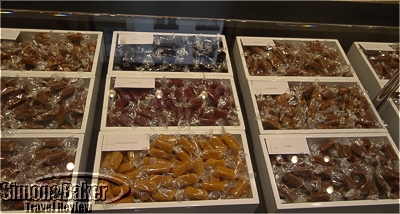
Caramels in a variety of flavors were on display in the Left Bank shop.
We also tried several caramels including the popular passion fruit as well as blackcurrant, raspberry, honey, almond, and salt butter. They were outstanding.
by Editor | Dec 1, 2014 | Food
Article and photos by Josette King
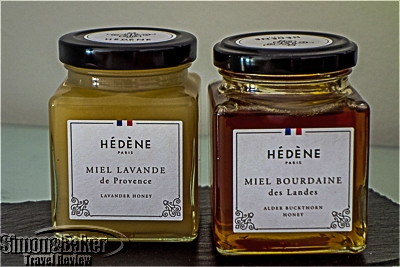
Signature Hédène cube jars were a common site on the shelves of gourmet shops
“Please hand me the rosemary honey,” my friend asked. I was wedged in a corner of her diminutive Paris kitchen where she was whipping up an impromptu dinner while we caught up after a long separation. “Honey in the vinaigrette?” I thought as I reached on the shelf above my head for a cube-shaped jar filled with rich amber liquid. “The rosemary,” she insisted, “the light one.” I glanced at the jar in my hand. A smart white label announced “Hédène Miel Sapin du Jura” (Jura Mountains Fir Honey). I reached up again for an identical jar, that one filled with a silvery concoction. “That’s lavender,” she said absentmindedly, arm stretching above me to retrieve a third jar just a notch darker, a pale champagne color. I couldn’t resist asking: “why do you need all this honey?”
“This is not just honey,” she pointed out, “it’s pure monofloral honey. The right one can do wonders for just about any dish. Smell it.” Having just branded myself a honey philistine, I inhaled the “Lavande de Provence.” It had a delicate, complex scent that took me back to warm Provencal evenings. “We’ll have it for dessert,” she volunteered, “drizzled over mixed red berries and yogurt.” By now I was taking a whiff of “Sapin du Jura.” It did hint at a walk in an evergreen forest. “We’ll try it for breakfast tomorrow; on pain perdu (French toast). Think of maple syrup, only much more subtle, with an elegant lingering palate.” I felt we had just crossed into the elite spheres of wine tasting.
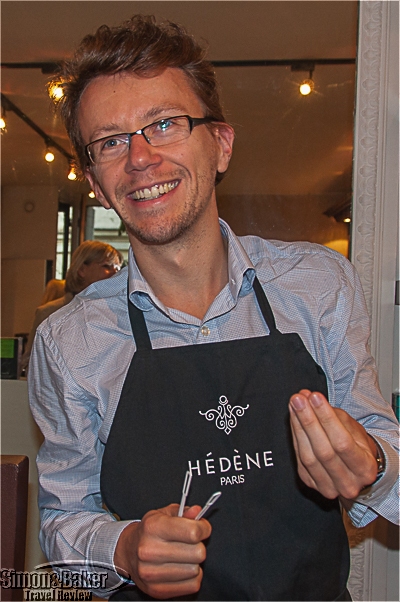
Cyril Marx explaining the finer points of monofloral beekeeping
This impression was confirmed a couple of weeks later when I attended an Hédène honey tasting at a Latin Quarter gourmet shop (86 rue de l’Université, 75007 Paris, France, +33 6 63 04 98 82 86, http://www.hedene.fr/en/, contact@hedene.fr ). I immediately spotted my three old acquaintances Sapin du Jura, Lavande de Provence and Romarin du Languedoc among a display of the signature cubes with their tailored white labels and black tops. The collection also included Acacia de Bourgogne (Burgundy Acacia Honey), Tilleul de Picardie (Picardy Linden Honey) and Châtaignier du Tard (Tarn Valley Chestnut Honey), lined in a palette ranging from the palest of golds to rich copper.
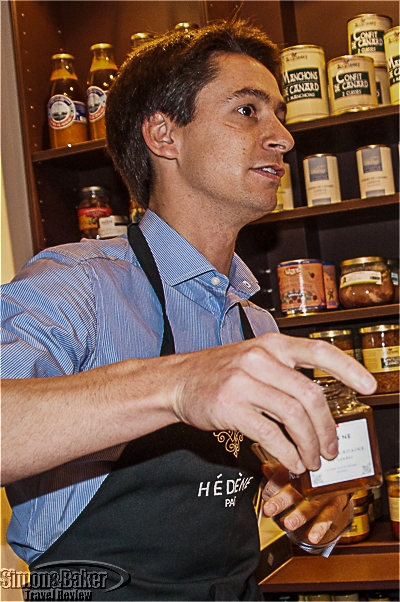
Alexis Ratouis conducting a tasting of Hédène honeys
But mostly I met the two enthusiastic young men clad in matching dark grey aprons, who were orchestrating the proceedings, Cyril Marx and Alexis Ratouis, the cofounders of Hédène, a brand of premium French monofloral artisan honeys created in 2013; and I got the answer to my unspoken question: what makes Hédène honeys so special that they have already garnered preeminent space on the shelves of épiceries fines (gourmet shops) throughout France; and gained staple status in the pantry of my Parisian gourmet friend?
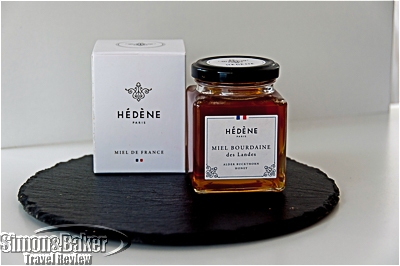
The newly introduced Bourdaine des Landes was the star of the honey tasting (click to enlarge)
Cyril and Alexis met at university in Paris and developed a friendship based on common interests including apiculture. Cyril’s family has kept hives in the Cevennes for four generations, while Alexis’ relatives keep their own bees in Savoy. Both men have enjoyed participating in honey harvests since childhood. Even as they completed their education and began their professional careers, they nurtured their passion for apiculture at le Rucher Ecole du Jardin du Luxembourg (founded in 1856, the Luxembourg Garden Hive is recognized as the oldest ongoing urban hive in France, and one of its most prestigious apicultural teaching institutions). After two years of intense planning, they decided to make it their career. Hédène was launched that year.
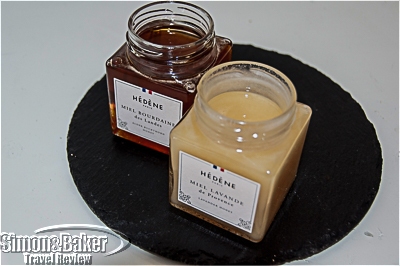
My current Hédène favorite French monofloral honeys
“We aim to take our customers on a journey of the diverse regions of France. All our honeys are unique monofloral vintages issued from a flower characteristic of its area of origin, each with its distinctive color, taste and texture,” Cyril explained.
In each area, they select artisans who uphold the highest standards of traditional beekeeping. Those chosen suppliers also commit to adhering to the rigorous specifications set by Hédène. But how do they ensure that the bees will make single flower honey? The selected beekeepers in areas where the target plant predominates must time the introduction of the hive and the actual harvesting of the comb to coincide with the peak blooming period. To be chosen as an Hédène product, the honey must be analyzed and laboratory certified to contain the required pollens.
Because of these rigorous requirements, as in the world of fine wines, the quantities of an especially prized vintage may be limited.
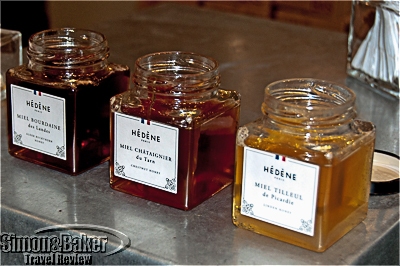
Hédène monofloral honeys ready for tasting (click to enlarge)
It was the case with the Miel Bourdaine des Landes (Adler Buckthorn Honey from the southwestern France Atlantic coast) being introduced that day. It was the color of fine Cognac, full bodied with a delicately astringent, quince-like finish. There will be no more than 2,000 jars available this fall, and with the holiday gifting season coming up I doubted they would last long on the market. I immediately purchased two jars, one for my honey connoisseur friend, the other one for myself. I can’t wait to hear what she thinks of it. As for me, I expect it will be delicious as a glaze for roasted pork tenderloin. And by the way, that tablespoon of Miel Romarin du Languedoc did work wonders for the vinaigrette on our mixed summer’s greens salad.
































































